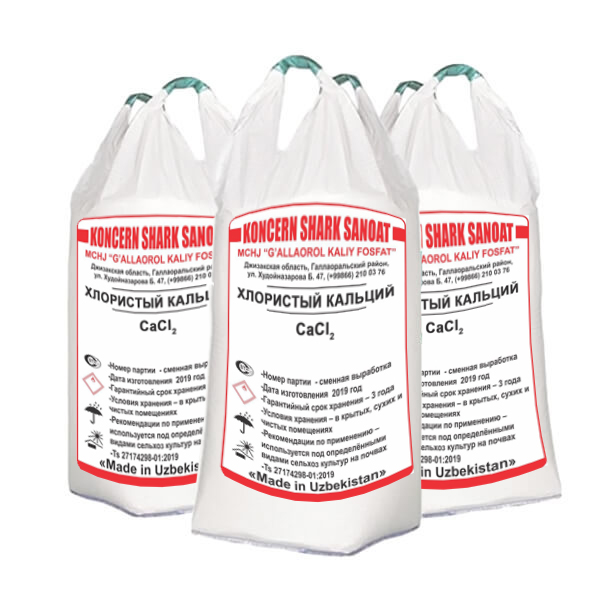
Calcined modified calcium chloride (CCC) is a highly effective solid reagent in granules, which is used for treating roads and streets in the temperature range up to -35, with a basic substance content of 94 – 98%. Technical calcium chloride quickly penetrates into the ice layer and requires the lowest consumption rates in comparison with other reagents.
PROPERTIES OF CALCIUM CHLORIDE ANTI-ICE REAGENT
HC has a strong hygroscopic property, therefore, falling on snow, the reagent begins to enter into a chemical reaction with it, while releasing strong heat. HKM does not allow the formation of ice and snow-ice rolls. In addition, laboratory studies have shown that this reagent not only melts the ice, but also improves the condition of the soil. Calcium replaces sodium that has accumulated in the soil during the use of industrial salt, and thus even fertilizes it.
FORMULA OF ANTI-ICE CaCl2
PACKAGING CALCIUM CHLORIDE ANTI-ICE CALCIUM CHLORIDE
Calcium chloride is packaged in 25 kg polypropylene bags.
ADVANTAGES OF ANTI-ICE REAGENT
has the property of faster and deeper penetration into the ice layer compared to other materials used to combat winter slipperiness
melts ice and fertilizes the soil
after cleaning does not leave marks on asphalt and paving slabs
helps to reduce the forces of adhesion of ice to the road surface due to the formation of brine
does not destroy concrete surfaces (over 1 year old)
increased activity of the reagent reduces consumption rates, which reduces the environmental load of chlorides on the environment
non-toxic to humans and animals
RATES OF CONSUMPTION OF ANTI-ICE MATERIAL HC
ICE REMOVAL MODE
| Ice thickness, mm Reagent consumption, grams / m² |
At air temperature, ºС | |||||
| 0-2 | -2 -4 | -4 -6 | -6 -10 | -10 -15 | -15 -20 | |
| 12 | ten | 15 | twenty | 25 | 45 | 65 |
| 3 – 5 | 25 | 35 | 45 | 65 | 90 | 140 |
SNOW CLEARING MODE
| Reagent consumption in the temperature range, ºС | |||||
| Temperature | Up to -4C | Up to -8 C | Up to -12 C | Up to -16 C | Up to -20 C |
| Chloride Calcium gram / m² | 15 | 35 | 45 | 55 | 65 |
SCOPE OF CALCIUM CHLORIDE
Technical calcium chloride is used in the chemical, forestry and woodworking, oil, oil refining and petrochemical industries, in refrigeration engineering, in construction and the manufacture of building materials, in non-ferrous metallurgy, in the construction and operation of highways, as well as as a desiccant and for other purposes.
In modern times, calcium chloride is widely used in construction. They are used to accelerate the hydration of the cement, allowing faster setting and shrinkage.
In addition, calcium chloride makes it possible to increase the strength of cement in relation to adverse environmental influences: frost, temperature extremes, etc. Thanks to calcium chloride, not only the quality of products made from cement increases, but also their productivity increases by about 2-3 times.
In the manufacture of silicate bricks, an active additive is used in the form of calcium chloride (or calcium hydrochloride), which help to achieve greater strength and frost resistance of products.
Calcium chloride is used in the production of ready-mixed concrete, concrete products and paving slabs.
Calcium chloride is widely used in medicine and pharmacology.
HC is also needed in agriculture. Calcium chloride is used as a source of calcium ion for a variety of fruits and vegetables.
STORAGE IN THE WAREHOUSE OF CALCIUM CHLORIDE
Keep out of the reach of children and pets, in closed warehouses. Storage in open areas on pallets is allowed.
TRANSPORTATION OF ANTI-ICE CALCIUM CHLORIDE REAGENT
Fast and timely delivery of calcium chloride by your own vehicles.
GUARANTEED SHELF LIFE OF CALCIUM CHLORIDE
12 months from the date of manufacture, subject to storage conditions and packaging tightness
GOST FOR CALCIUM CHLORIDE
SAFETY REQUIREMENTS FOR ANTI-ICE REAGENT
TECHNICAL CALCIUM CHLORIDE (calcium chloride) GOST 450-77
| Indicator name | Norm for brand and grade | ||||
| Calcined | Hydrated | Liquid | |||
| higher | the first | ||||
| 1. Appearance | White powder or granules | Flakes or granules of white or gray color | A solution of yellowish gray or greenish
colors transparent or with light haze |
||
| 2. Mass fraction of calcium chloride,%, not less | 96.5 | 90.0 | 80.0 | 35.0 | |
| 3. Mass fraction of magnesium in terms of MgCl2,%, no more | 0.5 | 0.5 | – | – | |
| 4. Mass fraction of other chlorides, including MgCl2, in terms of NaCl,%, no more | 1.5 | – | 5.5 | 3.0 | |
| 5. Mass fraction of iron (Fe),%, no more | 0.004 | 0.004 | – | – | |
| 6. Mass fraction of water-insoluble residue,%, no more | 0.1 | 0.5 | 0.5 | 0.15 | |
| 7. Mass fraction of sulfates in terms of SO4² -,%, no more | 0.1 | – | 0.3 | – | |
TECHNICAL CALCIUM CHLORIDE
(calcium chloride)
GOST 450-77
Safety requirements
| Hazard Class | 3 |
| The main properties and types of danger of PGM | |
| Basic properties | Solid product – powder, granules or flakes of white or gray color, liquid – a solution of yellowish-gray or greenish color, transparent or with a slight turbidity. |
| Explosion and fire hazard | Fire and explosion proof. |
| Danger to humans | Calcium chloride quickly absorbs moisture, with systematic exposure irritates and dries the skin, especially irritates the mucous membranes of the upper respiratory tract and eyes. |
| Individual protection means | Overalls, safety footwear, personal protective equipment. |
| Action to be taken in an emergency | |
| General | |
| In case of leakage, spillage and spillage | |
| In case of fire | |
| Neutralization | |
| First aid measures | In case of contact with skin and eyes, wash with plenty of water. |
Sale of an anti-icing agent Calcium Chloride is carried out at low prices, taking into account delivery across the Republic of Uzbekistan, and self-pickup. Other modern anti-ice reagents are always available in stock.

